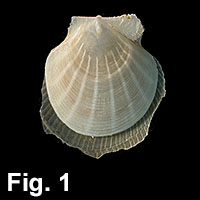|
< Previous family introduction |
|
|||||
 |
Family Propeamussiidae Propeamussiids
|
|||||
|
The Propeamussiidae is a family of generally small, deep sea, often fragile bivalves. Huber (2010) gave the number of species worldwide as 150, but it can be expected that more will be discovered because of their seldom-sampled deep water habitat. They occur worldwide, including in the Arctic and Antarctic, but about half of the species occur in the Indo-West Pacific. Most species live in the bathyal zone (200-2000 m depth) with some extending into the abyssal zone (below 2000 m). Members of this family are very unusual in being carnivorous, a method of feeding rarely developed in bivalves. Morton & Thurston (1989) found that prey consisted of foraminiferans, minute crustaceans and molluscan veliger larvae, which are caught in an inrush of water to the mantle cavity and pushed to the mouth by the foot. Most of the NSW species have a well-developed byssal notch, implying that they attach by a byssus to the substrate, but no observations are available of them alive. There are six species occurring in NSW. One species is fairly large – up to 44 mm in height – but the rest are under 10 mm. The most common species, Parvamussium thetidis, is one of the most frequently obtained shells in deep water dredge samples, but the other species are uncommon or rare. In NSW they are known from 110-1840 m deep. Family Reference Dijkstra, H.H. & Beu, A.G. 2018. Living scallops of Australia and adjacent waters (Mollusca: Bivalvia: Pectinoidea: Propeamussiidae, Cyclochlamydidae and Pectinidae). Records of the Australian Museum 70: 113-330. Coverage All the described species from NSW are detailed here. Identification Notes Shells are inequivalve, with the left valve larger than the right, as shown in Fig. 1. When alive, the left valve encloses the right valve. The right valve has a firm margin, but the left often has a ragged broken edge. The sculpture of the two valves is different, with some combination of commarginal and radial sculpture. The family is unusual in having strong radial ribs internally in some genera. There is a byssal notch in the right valve. Fig. 1 Off Kiama, NSW, 450-500 m (C.165525). Joined pair, right valve uppermost.
|